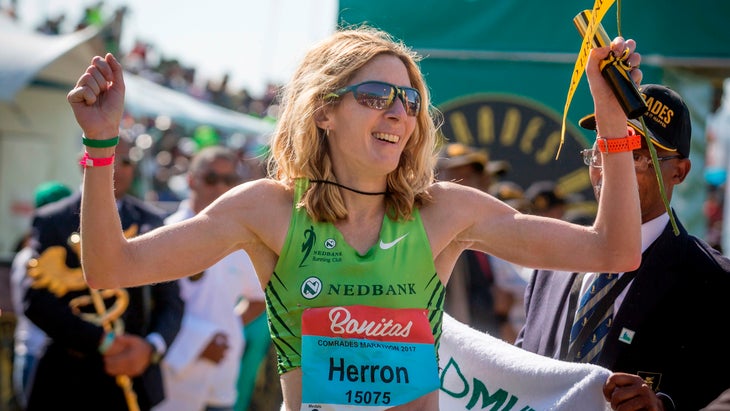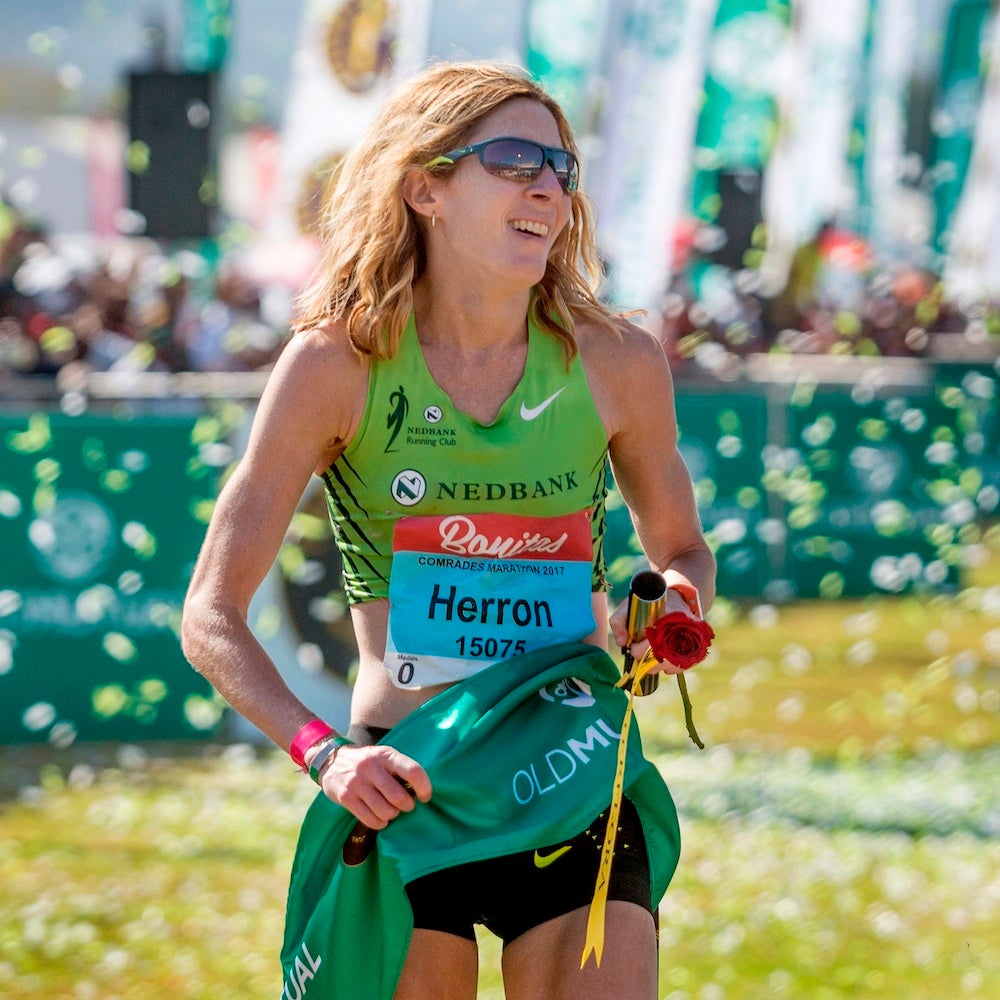In January, my social media feeds were filled with the typical new year posts—year-end recaps, reflections and resolutions, and hopes for the coming year. But one caught my eye.
Ultrarunner Camille Herron shared one reason why she thought she was “crushing world records” in her forties: She only does one or two long runs a month (nothing over 22 miles) and she never does back-to-back long runs. Case in point: she ran one easy 20-miler in the lead-up to the Jackpot Ultra Running Festival’s 100-mile race last year, which she won outright. Instead, she focuses on cumulative volume and running frequency.
In her words, “Long runs are overrated.”
In the world of ultrarunning, where there’s a bravado around epic big-mileage days, Herron seems like an anomaly. Among the replies to her tweet, there was curiosity tinged with a side of skepticism. How could an ultra-distance athlete—one who holds world records for 100 miles and for the longest distance covered in 24 hours—run no longer than what you’d typically do in a marathon build-up? Shouldn’t her training mirror what she’d need to do in an ultra?
Karen Troy saw Herron’s tweet too. But her first thought was, “Wow. Someone’s actually trying to do it.” To Troy, who’s a professor of biomedical engineering and the director of the musculoskeletal mechanics lab at Worcester Polytechnic Institute, Herron’s training philosophy reflected what she’d read in scientific journals and seen in the lab related to mechanical stress and bone adaptation. “To me, it really aligned well with a lot of the theory,” she says.
How Bone Adapts
Bone is a dynamic tissue. It changes, adapts, and gets stronger in the same way that muscles do. And in order for them to get stronger, you have to load them.
Bones have a “set point”—akin to the thermostat in your house—for the optimal amount of mechanical stress it wants to experience. Depending on the amount and rate of force transmitted through the bone, bone cells respond by either adding or removing bone. Too much force and the cells build bone to temper the load. Too little force and the cells get rid of bone so that it can sense more load.
Scientists have long been interested in finding the sweet spot between the amount of physical activity that induces adaptation and strengthens bone and the amount that can lead to injury—a fine line that many runners are intimately familiar with. What they’ve found in with animals like mice and rats is that, after back-to-back loading cycles, bone cells start to ignore the mechanical stress and stop adapting. Troy says it’s like when you walk into a smelly room. “It smells pretty bad for 10 to 15 minutes, and then you adapt. If you stay in the room, it stops smelling,” she says.
However, just like your nose can become re-sensitized if you leave the smelly room, bone cells do too. have found that bone cells start to pay attention to mechanical stress again after a four-to-eight-hour rest period. When you spread the load over multiple sessions rather than one sustained bout, you gain more bone. ( respond similarly.)
The evidence suggests that distance running has diminishing returns when it comes to bone health. Troy hypothesizes that bone may respond to the stress of running over the first half mile or so but then become desensitized to the monotonous, repetitive loading. “You’ll get muscle and cardiovascular adaptations, but your bones aren’t paying attention anymore,” Troy says. “You’re just adding miles and potentially accumulating damage, but you’re not going to add adaptive stimulus that will help the bone become stronger.”
A Case Study of One
There isn’t a lot of data in people, making Herron an interesting case study. “Humans are made to move frequently,” Herron says. “The body responds to change and dynamic stimuli, so you need to stress the body in different ways.” It’s an approach she believes can work for runners at all levels and distances.
Her training is peppered with frequent, shorter bouts of running. Most days, Herron will run 10 to 15 miles and then doubles back for six or seven miles after a four-to-eight-hour rest period. Over a two-week period, she completes four main workouts—short intervals like 400-meter repeats; long intervals like one-to-three-mile repeats; a progression run, usually incorporated into a long run; and a hill session where she stresses both the uphill and downhill components to load her body eccentrically.
In between workouts, she runs easy and incorporates strides and drills twice a week. She likes to race a marathon or 50K a couple of weeks before a big race as a way to practice her nutrition and stress her body “just enough.”
“You can’t just look at a singular long run or back-to-back long runs. You have to look at the whole picture. Every run is like bricks that add up over time,” she says. Over the years, Herron has played around with her training formula and has cut back on her long runs, emphasizing quality over quantity and running for time rather than just distance. “I’m totally fine doing two hours as my long run,” she says.

It makes sense that Herron’s training is steeped in science. She was pre-med at the University of Tulsa before turning her focus to scientific research, studying the impact of strength training on bone and muscle. In graduate school at Oregon State, she investigated the relationship between mechanical stress and bone recovery for her master’s thesis. By studying bones, maybe she hoped to understand why she experienced multiple stress fractures in high school and college. What she learned shaped how she trains.
But she didn’t put the theory into practice right away. Early in her marathon career, she was still doing long runs up to 26 miles. It wasn’t until she started training at altitude that she began to split up her runs. Her coach (and husband) Conor Holt thought it would help her acclimate to the altitude, but she says, “It was like a rocket to the moon.” She recovered better and felt more spark in her legs.
Sabrina Little, ultrarunner and five-time U.S. National Champion, has also seen the benefits of this style of training. In college, she used to log big miles, a 30-mile run before doubling back for another 20 miles the next day. But once she graduated, she no longer had the luxury of dedicating endless hours to training. She expected to be less prepared for races but a funny thing happened—she performed better. It turns out that running multiple times a day may have other too.
“When I set the American record in the 24-hour run, my longest run was maybe 16 or 17 miles,” Little says. She would train in the morning and then come back for a faster session in the afternoon. “Breaking things into shorter blocks was beneficial. I was able to do higher integrity work instead of just long, slow distance,” she says. She thinks it helped her body absorb her training.
Now, as a parent to two young kids, Little definitely doesn’t have long blocks of time, so she practices what she calls “prepositional running”—before things, between things, and after things.
However, both Herron and Little logged many miles before happening upon their current training strategy. “I don’t want to say big days aren’t needed, but it’s hard to say what role they play,” Little says. “There’s a way in which the big races are kind of grandfathered into your legs, like you’re never too far away from your last 50-miler.”
Beyond Mechanical Stress
While Herron and Little’s training mirrors research findings, it can’t be considered in isolation.
There are other factors that influence bone health and adaptation aside from mechanical loading—genetics, nutrition, running gait, and how much bone you laid down during your peak bone-building years. Hormonal health matters, too, because bone cells have sex hormone receptors. If your hormone levels are low, Troy says it tips the balance toward bone removal, leaving the tissue more vulnerable to injury.
Whether or not eschewing long, sustained bouts of running is the key to success and injury prevention, there are benefits to fostering the idea that not everyone needs big days on the road or trails.
“Most people have responsibilities and can’t spend all that time outside,” says Little. “People should know there are other possibilities. It could get a broader scope of people participating.”


